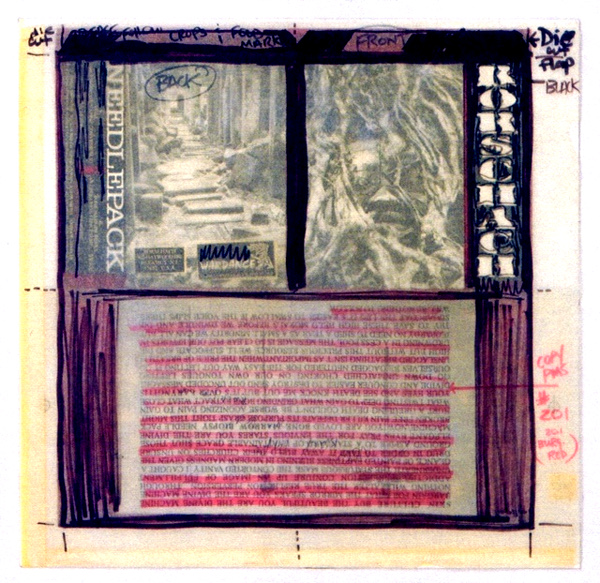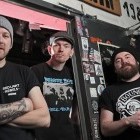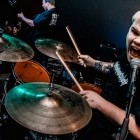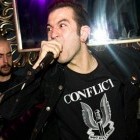
This year marks the 25th anniversary of having had the good fortune of being involved with releasing Rorschach's Needlepack EP. The record has stood the test of time, it is still as fresh and vital as when it was recorded. The guys in Rorschach were the most technically proficient musicians out of the early ABC No Rio scene when I first met them, circa 1990. It is to their credit that they used these skills in an ingenious matter, eschewing self-masturbatory musical excesses and creating a unique hybrid of metal and hardcore.
I have to put into context what the band was going through at the time. Singer Charles Maggio had been undergoing a series of medical procedures meant to diagnose and treat a life-threatening ailment. The lyrics and song titles reflected this ordeal—"Bone Marrow Biopsy (An Operation I Once Had... Twice)," or as he put it, a song about "an operation I had... twice." The inner layout of surgical needles on display gave a profound meaning to the name of the record. The sense of urgency and despair in the vocals came from a place most of us would not care to know.
I wanted to chronicle the evolution from their earlier Die Kruezen/Bl'ast! influenced Remain Sedate LP. They were fast becoming their own band, creating a singular dissonant sound, and Needlepack is a big part in that progression. The songs ingeniously sum up disparate influences, laying a blueprint for what a lot of bands in the '90s went on to emulate and build on. To this day, I read articles on how Rorschach influenced sub-genres such as metalcore, or the dreaded screamo phenomenon. While that might be true, I don't particularly care for those bastard offspring. I think they missed the point, taking some of the outward musical trappings and ignoring the essence of the band's music. For my money, Rorschach did it first, and definitely better.
To commemorate Needlepack's quarter-of-a-century anniversary, I asked band members, their roadie, and the EP's layout designer to weigh-in on those times and the record's legacy.
Cast of Characters:
- Charles Maggio (singer)
- Keith Huckins (guitarist)
- Nick Forte (guitarist)
- Andrew Gormley (drums)
- Will Tarrant (roadie)
- Melissa York (layout and design)
I have to mention my old friend, Dave Koenig, who did the great Hardware/In Memory Of zines. Dave slept over at my house several times, working throughout the night to meticulously glue each cover, long after I had tired and passed out. Thank you, Dave! I sincerely hope no long-standing health issues developed as a byproduct of inhaling all those glue fumes!
Do you have any memories of the recording process that stick out?
Andrew Gormley: We were really happy with the recording process for the Remain Sedate LP. It was with a local engineer, Allan Speers, who had a recording studio in the basement of his parents' house. Remain Sedate ended up sounding much better than we expected, and I give a lot of credit to Allan for that. It made sense that we would record Needlepack with Allan. We went into the Needlepack session with a bit of confidence that we didn't have previously. With this newly found confidence came complacency. I personally thought that I could just show up, play through the songs a few times, and Allan would make the drums sound great. Just like he did with Remain Sedate. But the complacency coupled with the fact that this was a shorter session, we ended up with a performance and a recording that didn't sound as good as the previous one.
One thing that sticks with me: [Born Against drummer] Jon Hiltz told me how he played Needlepack for "a friend." This "friend" told him that the drums sounded like they were played by a 15-year-old. Fucking Hiltz. During the recording process, I experimented with a keyboard track over the middle of "Skin Culture." This happened when Keith wasn't around. I don't think he would have entertained such nonsense. It didn't add anything to the song, so I don't think we included it in the final mix. There's something subtle, or maybe not so subtle, in which we started trying to "connect" the records. "Ugly," as the beginning of Needlepack, was actually the end of the last song on Remain Sedate, "Oppress." And we took that concept on to Protestant, where the noise at the beginning of "Mandible" was a callback to the end of "Laryngitis." And we purposely ended "Ornaments" with a tape slow-down effect, with the intention of starting the next recording with a similar effect, which never happened since we broke up.
Charles Maggio: I remember little about the recording process. In fact, so little that I had to look up where we recorded it. Then I remembered it was the same place we recorded Remain Sedate. The guy that recorded it had no idea what we were trying to do, he was not a fan of hardcore, so it was a bit of an uphill battle trying to get the sounds we wanted for the record.
Nick Forte: Nothing in particular. We weren't thrilled with the recording of Remain Sedate, so I can't for the life of me understand why we went back to the same studio, but we did. This recording got closer to what we wanted to sound like on record. It was difficult to get good recordings in those days as a hardcore band.
Keith Huckins: Because we were so inexperienced, we stupidly let the engineer dictate the sound to us. We really shouldn't have went back to that guy, he was a bit of a dick. I just listened to it again and I find it thin as hell
Will Tarrant: I do recall assembling this record, as well as all the Vermiform stuff, the night before the '91 tour. My band, Animal Crackers, played WFMU and then we all drove to Sam and [Born Against guitarist] Adam Nathanson's place to help you guys.

What was influencing you guys musically at that time?
Nick: We were definitely influenced by the more complex song structures of Neurosis' Word as Law. We were listening to it a lot when we wrote these Needlepack tracks, probably that and Pissed Happy Children/Neanderthal. Keith wrote some of the riffs on the Needlepack tracks after borrowing my bass guitar, and writing on bass rather than guitar, so they have a bit more of that [PHC/Neanderthal bassist] Eric Wood vibe. Keith came up with most of the music, but we did a lot of collective arranging, especially on "Skin Culture." That was the most complex arrangement we had attempted up until then, so it took a lot to work it out. I wrote the lyrics to that one.
Andrew: I was fully into Slayer and Metallica. A lot of the drum fills, especially in the beginning of "Laryngitis," were my attempts at Dave Lombardo-style fills. But I also was listening to a lot of classic rock at the time, and took a bit of influence from there. The intro drum fill in "Skin Culture" is actually taken from the intro to Heart's "Barracuda"! "Oooh, barracuda..." Chris and I would always find a classic rock station on the van radio. It drove the other guys bonkers. I think it offended Nick's musical sensibilities the most. The middle of "Skin Culture" was an opportunity for me to start exploring my own style. It was the first time that a guitar player ever said something along the lines of, "I'm going to play some open chords, and drums and bass can do something on top." Chris did some repeating line on bass, while I did some "falling down the stairs" drum thing. This bass/drum interplay is something that became a big part of my drumming and songwriting post-Rorschach.
Keith: Musically I'm thinking it was Voïvod, Prong, Slayer, Cro-Mags, and Black Flag for the main influences. I think, I may be wrong, that I came in with most of "Skin Culture" and "Laryngitis" as a musical framework and then we worked as a band.
SEE ALSO: 2014 interview with Keith Huckins (Rorschach, Deadguy, Kiss It Goodbye).
What was the inspiration for the cover and the overall gatefold layout of the 7"?
Melissa York: That I don't remember. A lot of times we all collaborated together. As far as getting imagery, things were a lot different back then. It wasn't as easy to do photo research. I remember learning about the free images from the Library of Congress from a teacher in my art school. I would walk over there and rifle through all this imagery. I know that is how I found the images for Remain Sedate. I thought they were cool, grabbed some copies, and brought them to the band. Maybe Needlepack happened the same way, I don't completely remember. I went to design school around this time and I had a very influential teacher. He was in bands in the early '80s, made a 7", etc. So, there was a lot he taught me on how to construct artwork for printing. I do know that I always appreciated a gatefold. My first memory of a gatefold was Sesame Street Fever... I loved that record [laughs].

Was Needlepack your first and only record design, or did you do other ones?
Melissa: Nope. I am not sure what my first was because of timeline, but I did a lot of design for bands and record stores. I think Remain Sedate was my first record art, and I created the Rorschach logo that they used all the time. There was a bunch of record art design around that time like The Manacled and Born Against. Funny story on Nine Patriotic Hymns for Children: I worked at a sign shop and made the CMYK acetates from the sign-making material. It's funny how you worked with what you had back then. It was really interesting to see the original art that you sent me. The fact that someone saved it, all of it. To see my handwriting and what you had to explain to the printer back then. So cool. That is a gem. So, again, I went to design school, so I could print stats and create the art. I am pretty sure that's how I did the art for Needlepack.

What were the lyrical and vocal influences on that particular EP?
Charles: "Bone Marrow Biopsy (An Operation I Once Had... Twice)" was written about a medical procedure I had to have done twice while getting treated for Hodgkin's disease. "Laryngitis" was influenced by some stuff happening in the hardcore scene at the time relating to censorship, and "Skin Culture" was written by Nick, so I would defer to him for that answer. I was till trying to figure out a "style" vocally. I mostly just screamed and hoped the rest of the band liked the way it sounded. Stylistically speaking, I think it is a good midway point bridging what my vocals on Remain Sedate sounded like to what they would eventually become on Protestant. Nick or I wrote lyrics for songs exclusively. Musically, Keith wrote a lot of the parts, but the entire band would put the parts together into a song. So, no song is exclusively written by any one person.
Do you think Needlepack was a "bridge" between Remain Sedate and Protestant, or does it stand on its own?
Nick: Sonically speaking, it falls somewhere between our two LPs. None of our records really sounded like what we wanted; but, hey, such is life. Like I said earlier, it was hard to go into a studio as a hardcore band and get something that sounded how you want it.
Andrew: On paper, Needlepack has a lot of connections to Remain Sedate, but little to Protestant. It was recorded in the same studio with the same lineup as Remain Sedate, before we did any real touring. But, musically and lyrically, Needlepack was all on its own, all Rorschach, and was very different than what we did previously. We still had our influences, but they took a back seat. If anything, Remain Sedate was the bridge.
How do you feel about the record now, and do you feel like it has stood the test of time?
Nick: I love the tracks on this single, it's a real leap in a direction we were interested in going on a musical level. Yeah, I think it stood the test of time, and the music holds up today.
Andrew: A lot of the bands that came out of that scene were known for their demos and 7"s. We chose to have our initial release be a full-length album, and now was our chance to take a step back and release a 7". They were popular, and fledgling labels such as Wardance could afford the risk. Only we didn't take a step back, and it was a bit forced. Song selection was simply the ones we had ready. A 12" EP probably would have been a better choice for us then. Speaking of fledgling labels, I remember that the first pressing of Needlepack arrived unassembled, which meant for all of our copies we had to glue the covers together by hand. Another "night before tour" merch scramble. A lot of them ended up being a bit lumpy.
I didn't view Needlepack as much of a success. The recording didn't sound as good, it was a small initial pressing, and we didn't see a second pressing for what seemed like forever. Thus, we ended up re-recording "Skin Culture" for Protestant and didn't put the whole recording onto the Autopsy discography CD due to time constraints. This pushed Needlepack even further into oblivion. Looking back at it, I love the cover, by far my favorite Rorschach cover, including the Pushead cover. The songs are great. We consistently played them all live. Fuck, at one show we played "Bone Marrow Biopsy (An Operation I Once Had... Twice)" like 13 times. And with all Charles was going through at the time, it makes the lyrics that much more powerful. So, yeah, I'm proud to have been part of Needlepack.
Keith: I can't listen to it, the recording hurts my feelings, although I think the songs themselves are strong. It is also my favorite artwork of all of the records I've played on.
Charles: I think the record looks great. I think it could sound better. It is not my favorite stuff by the band, but 25 years later I still think it is a solid record, which documented us at that time pretty much perfectly.
Melissa: I have to re-listen. It's been a while! Lately, I have been super nostalgic with the old music I loved back then. Rorschach were great friends of mine and I cared for them deeply. When you are in it, you never realize that what you are a part of is something groundbreaking until 25 years pass! As far as layout, I really appreciate it now, being able to look at the original and seeing all the work that went into design then. Now, it's computers and it's so, so, so different and easy!
Will: I love that record even more than when it came out, because I've been able to enjoy it for the last 25 years! Has it stood the test of time? Of course it has! The opening to "Skin Culture" is just as fierce as when I first heard it! Its the definitive Rorschach riff!
Endnote:
Props to Rorschach bassists Chris "The Luchinator" Laucella, Thomas Rusnak, and "Sub" guitarist Jon Hiltz.




















